Studying the life and death of amphibians in the Snoqualmie Valley
Oxbow Farm & Conservation Center staff recently completed a study of the frogs and salamanders found in Snoqualmie Valley ponds and – perhaps more unusually – on the valley’s roads.
We are all aware of the seasonal migrations of songbirds, which fly south to distant wintering grounds and return faithfully to our forests and yards every spring. Fewer of us know about the seasonal migrations of our local frogs and salamanders. Many of our native frogs and salamanders (see informational box) lead dual lives, burrowing under logs, leaves, or forest soil during the winter but returning to ponds and wetlands in the late winter or spring to breed. If you live near a wetland favored by our Pacific tree frog (Pseudacris regilla), you have heard the amorous clamor that marks their gatherings in early spring. The seasonal trip from the nearby forest to a local pond may not be as spectacular as an arctic tern’s flight across the globe, but it is a marathon for these small, relatively slow-moving animals. What’s more, during their journey, they are especially vulnerable to predators, crushing vehicle tires, and the many changes humans have made to our landscape.
Long-toed salamander
(Ambystoma macrodactylum)
These early-breeding local amphibians begin depositing egg masses in January.
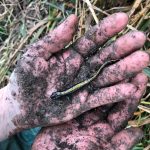
Northwestern salamander
(Ambystoma gracile)
This salamander protects itself with a toxic white secretion from glands in its skin.
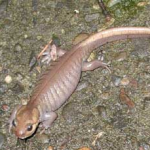
Pacific tree frog
(Pseudacris regilla)
Also called chorus frogs, these tree frogs produce the raucous “kre-ek” calls that resound through spring wetlands.
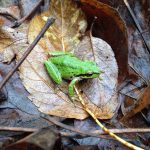
Northern red-legged frog
(Rana aurora)
These frogs are forest wanderers, traveling as far as 3.1 miles (5 km) from their natal ponds.
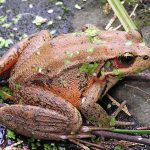
Photos: Northwestern salamander courtesy of WikimediaCommons/USGS; Northern red-legged frog photo by Don VandeBergh; Remaining photos by Oxbow Center staff.
Also, though they don’t grab our attention the way returning songbirds do, there is reason to worry about these small travelers. Globally, amphibians (the group of animals that include frogs, toads, and salamanders) are the most threatened group of vertebrates. More than a third of the world’s amphibian species are listed as threatened, and many populations are challenged by diseases, climate change, invasive species, and habitat loss or fragmentation. Washington State is no exception to this pattern; we have seen two species that used to be common denizens of the lowlands of western Washington, the Oregon spotted frog and western toad, nearly disappear from this area.
In light of this global crisis, conservation scientists are working to monitor the health of our amphibian populations in the Pacific northwest and better understand what we can do to protect them. Oxbow’s study (supported by funding from Conservation Research and Education Opportunities, a Seattle-based non-profit) focused on the status of amphibians in the Snoqualmie valley east of Seattle.
One of the questions that Oxbow researchers were trying to answer is whether roads, especially high-traffic highways, are keeping amphibians from making their seasonal migration to ponds in the Snoqualmie floodplain, where they could breed. The first step of the study was a series of all-night driving and walking surveys to assess where amphibians were crossing the valley’s roads and what the evidence was for roadkill impacts to these species.
What we found on Snoqualmie Valley roads
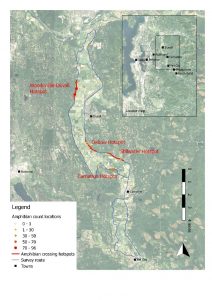
The nocturnal surveys, covering the approximately 60 miles of roads up and down the valley edges, revealed that thousands of amphibians meet their death seasonally at certain “hotspots” as they try to move across valley roads to preferred habitat.
Specifically, Oxbow researchers observed 2,634 road-killed amphibians on roadways over those 3 nights – mostly (98%) Pacific tree frogs. We identified 4 crossing hotspots where these frogs (and some salamanders and newts) were crossing in great numbers (Figs. 1,2).
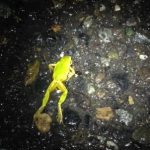
Can anything be done about this carnage? Across the country, non-profits, governments, and concerned individuals are encountering similar grisly scenes of roadkill and are experimenting with various solutions, from volunteer bucket-brigades in Oregon, New York, and Massachusetts to installing wildlife underpasses. Our road study is just a first step: Oxbow hopes to continue assessing the Snoqualmie Valley hotspots to determine if and how they could become effective sites for such amphibian-crossing structures or other conservation efforts.
What we found in Valley ponds
The road surveys showed that at least one species was experiencing substantial mortality on our roads, but didn’t tell us whether habitat fragmentation from roads was keeping amphibians from accessing valley ponds. To get an initial handle on this question, Oxbow staff donned waders each month from February to June 2018 to count egg masses and evaluate amphibian abundance in 11 ponds spread along the lower Snoqualmie Valley.
The monthly egg-mass counts showed that four pond-breeding amphibians (northwestern salamanders, red-legged frogs, Pacific tree frogs, and long-toed salamanders) are breeding in the studied floodplain wetlands and ponds, even in some sites that are cut off from upland forests by roads.
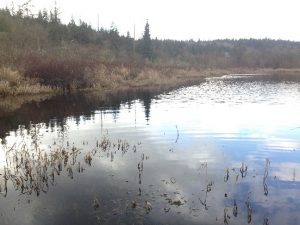
We found many (up to 142) native amphibian egg masses in some of the ponds, indicating healthy populations of some of these species. On the other hand, numbers and diversity of amphibian eggs in some ponds (including large, deep oxbow lakes) were fairly or quite low (<10 egg masses). The data give some hints as to why this might be, although more work is necessary to test these ideas. First, there was a positive relationship between the amount of fringing, grassy wetlands (where many amphibians prefer to lay their eggs) around the pond and the abundance of northwestern salamander eggs. So, managing landscapes to preserve or restore ponds with gradual, sloping wetland edges may be one key to helping this chunky, grey salamander to remain relatively common in the valley.
Two other important factors that are likely influencing amphibian success is the presence of fish and invasive bullfrogs. Fish were observed in many of the ponds, and other researchers have noted that predatory fish are quite common in the Oxbows and ponds in the valley. Finally, there is reason to think that the loss of forest land on the surrounding landscape might have had a negative impact on at least one member of the amphibian community: northern red-legged frogs.
Frogs need forests!
We noted that many amphibians need to move to forest habitats to spend the winter. There is increasing evidence that northern red-legged frogs in particular need substantial forest area to maintain populations, and that landscapes with less than half forest cover are unlikely to have many frogs. Although there is still substantial forest east and west of the valley, it is broken by clearing and the valley itself is largely converted for agriculture. Maintaining this species in western Washington will require thoughtful conservation of remaining forest lands.
Oxbow plans to continue investigating the ways that salamanders may be using floodplain forest areas, and perhaps obviating the need to cross those dangerous roads between their ponds and the higher, drier upland forests.
Seasonal versus permanent ponds
In some places in the valley, water pools in the wet months only to dry out by June or July. Other sites are wet year-round. Our study sites included mostly permanent water bodies but had a few seasonal wetlands, and our observations support a general theme in amphibian research: different hydrologies support different species (Figure 2). Although one, large seasonal wetland we studied demonstrated this most prominently, it seems that seasonal wetlands might provide the best places for long-toed salamanders and perhaps Pacific tree frogs to thrive, while northwestern salamanders, which more often require permanent waters to complete their slower development, are more capable of coexisting with the fish and abundant bullfrogs in the permanent ponds. So far, these observations corroborate the idea that preservation of a mix of permanent and seasonal waterbodies is important to conserving our native amphibians. Seasonal wetlands may need special care and conservation, since many have been converted to farmland, permanent farm ponds, or other land uses.
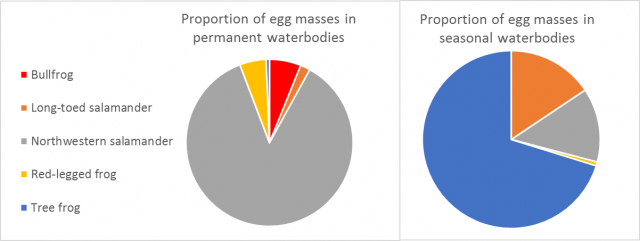
What can we do?
Oxbow plans to continue monitoring and studying the valley’s amphibians, as well as restoring native habitat to improve the chances for these and other wild species. You can join the fight to save our frogs and salamanders by joining Woodland Park Zoo’s amphibian monitoring program, by supporting the Washington Department of Fish and Wildlife’s important wildlife programs, and by keeping your eyes out for similar roadkill hotspots in the first rainy nights of fall or the first warm rains of the spring. If you have observations about Snoqualmie Valley amphibians, contact Oxbow Staff Ecologist, Matt Distler at matt@oxbow.org. And, if you own land, keep in mind that wet areas, native vegetation, and forests are important wildlife habitat. Keeping those areas natural is a huge gift to our amphibious friends!
Article by Oxbow Staff Ecologist Matt Distler, Ph.D
December 17, 2018
